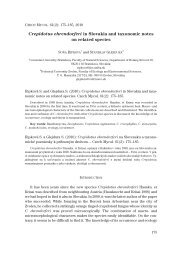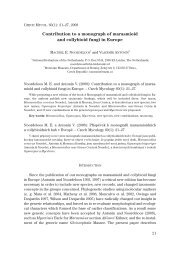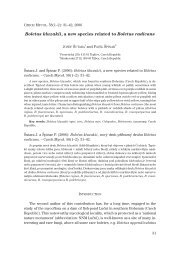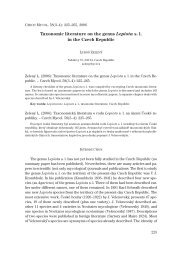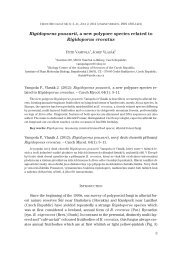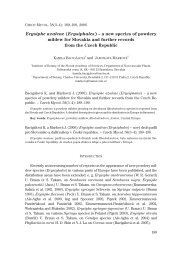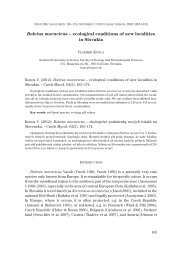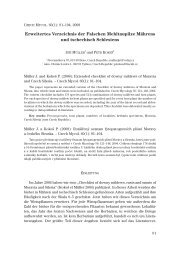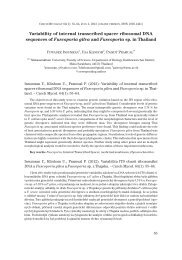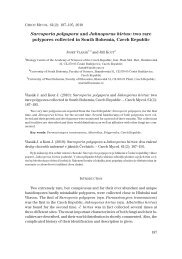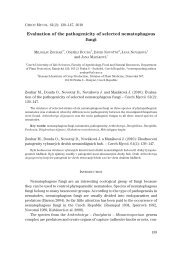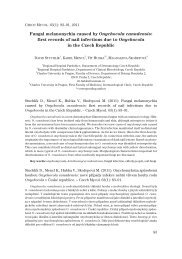Studies in the genus Mollisia sl II - CZECH MYCOLOGY
Studies in the genus Mollisia sl II - CZECH MYCOLOGY
Studies in the genus Mollisia sl II - CZECH MYCOLOGY
Create successful ePaper yourself
Turn your PDF publications into a flip-book with our unique Google optimized e-Paper software.
<strong>CZECH</strong> MYCOL. 58(1–2): 125–148, 2006<strong>Studies</strong> <strong>in</strong> <strong>the</strong> <strong>genus</strong> <strong>Mollisia</strong> s. l. <strong>II</strong>:Revision of some species of <strong>Mollisia</strong> and Tapesiadescribed by J. Velenovský (part 1)ANDREAS GMINDERMaurerstr. 22, 07749 Jena, Germanyandreas@mollisia.deGm<strong>in</strong>der A. (2006): <strong>Studies</strong> <strong>in</strong> <strong>the</strong> <strong>genus</strong> <strong>Mollisia</strong> s. l. <strong>II</strong>: Revision of some speciesof <strong>Mollisia</strong> and Tapesia described by J. Velenovský (part 1). – Czech Mycol.58(1–2): 125–148.The author presents <strong>the</strong> results of his revision of several mollisiaceous species described byJ. Velenovský. Some of <strong>the</strong>se are seen as good species and are comb<strong>in</strong>ed <strong>in</strong>to <strong>Mollisia</strong>: M. ladae comb.nov., M. peruni comb. nov., M. phragmitis comb. nov., M. velenovskyi nom. nov. Tapesia se<strong>sl</strong>eriae isseen as a nomen dubium and <strong>Mollisia</strong> se<strong>sl</strong>eriae ss. Krieglste<strong>in</strong>er (1999) is <strong>the</strong>refore described asM. lothariana spec. nov.Key words: Ascomycota, Helotiales, Dermateaceae, Mollisioideae, type studies.Gm<strong>in</strong>der A. (2006): Studie rodu <strong>Mollisia</strong> s. l. <strong>II</strong>: Revize některých druhů rodů<strong>Mollisia</strong> a Tapesia popsaných Josefem Velenovským (část 1). – Czech Mycol.58(1–2): 125–148.Autor předkládá vý<strong>sl</strong>edky své revize některých druhů mollisioidních hub popsaných J. Velenovským.Některé z nich jsou dobrými druhy a jsou přeřazeny do rodu <strong>Mollisia</strong>: M. ladae comb. nov., M. perunicomb. nov., M. phragmitis comb. nov., M. velenovskyi nom. nov. Tapesia se<strong>sl</strong>eriae se jeví jako pochybnýdruh a <strong>Mollisia</strong> se<strong>sl</strong>eriae ss. Krieglste<strong>in</strong>er (1999) je proto popsána jako M. lothariana spec. nov.INTRODUCTIONVelenovský (1934) <strong>in</strong> his circumscription of <strong>the</strong> family <strong>Mollisia</strong>ceae Rehm <strong>in</strong>cludes<strong>the</strong> genera Belonidium, Belonopsis, Cejpia gen. nov., Coronellaria,Crustula gen. nov., <strong>Mollisia</strong>, Niptera, Tapesia and Trichobelonium. Velenovský(1947) later added <strong>the</strong> new (monotypic) genera Capricola, Cornuntum,Pseudoniptera and Rob<strong>in</strong>cola. In this part of <strong>the</strong> study <strong>the</strong> types of Pseudonipteraas well as several species of <strong>Mollisia</strong> and Tapesia were exam<strong>in</strong>ed.125
GMINDER A.: STUDIES IN THE GENUS MOLLISIA S.L. <strong>II</strong>1a1bFig. 1. <strong>Mollisia</strong> anser<strong>in</strong>a Velen. (PRM 152223 = holotype).a. Ascospores. b. Marg<strong>in</strong>al cells. Del. A. Gm<strong>in</strong>der (scale bars = 10 μm).<strong>Mollisia</strong> betul<strong>in</strong>a Velen., Monogr. Discom. Bohem., p. 117, 1934 Fig. 2a-bC o l l e c t i o n e x a m i n e d : Czech Republic, Bohemia, Mnichovice, Kunice,ad truncum Betulae, 29. IX. 1928, leg./det. J. Velenovský (PRM 152300 = holotype).The packet of PRM 152300 is <strong>in</strong>dicated as a lectotype, but I can see no reasonwhy this should not be <strong>the</strong> holotype. No o<strong>the</strong>r collection was mentioned byVelenovský and <strong>the</strong> data on <strong>the</strong> label („Mnichovice, Kunice, ad truncum Betulae,29. 09. 1928“) agree fully with <strong>the</strong> protologue („<strong>in</strong> superficie trunci secti Betulaeprope Kunice <strong>in</strong> copia vasta, sept. 1928“).It conta<strong>in</strong>s two small pieces of hardwood (approximatively 1 cm 2 each), conta<strong>in</strong><strong>in</strong>gmany apo<strong>the</strong>cia <strong>in</strong> apparently overmature state.D e s c r i p t i o n . Apo<strong>the</strong>cia small, saucer-shaped, hymenium ochraceous greyish.Ectal excipulum consist<strong>in</strong>g of a textura globulosa-angularis consist<strong>in</strong>g ofbrownish cells. No subicular hyphae were observed. The marg<strong>in</strong>al cells are <strong>in</strong>conspicuous,balloon-shaped and ± greyish brown. Medullary excipulum andsubhymenium are of a yellow-brownish textura, <strong>the</strong> coloration apparently due to<strong>the</strong> bad condition of <strong>the</strong> specimen and most likely hyal<strong>in</strong>e <strong>in</strong> fresh state. The sameis true for <strong>the</strong> hymenium, so that a possibly positive reaction with KOH may havebeen masked. Therefore it is not clear, whe<strong>the</strong>r this is a KOH-positive species ornot. Paraphyses cyl<strong>in</strong>drical, approximatively 2 μm broad. Asci 50–60 × 5–6 μm,clavate. Due to <strong>the</strong> poor state of <strong>the</strong> apo<strong>the</strong>cia it could not be verified whe<strong>the</strong>rcroziers are present or absent. Porus react<strong>in</strong>g blue <strong>in</strong> IKI, with and without KOHpretreatment. Ascospores broadly elliptical, ovoid to <strong>sl</strong>ightly ciborioid, endsrounded, rarely with one small drop near each end, 4–5.1–6 × 2–2.3–2.8 μm (10/1/1<strong>in</strong> KOH), Q = 1.8–2.2–2.3(2.7), vol. = 9–14–20 μm 3 .127
<strong>CZECH</strong> MYCOL. 58(1–2): 125–148, 20062a2bFig. 2. <strong>Mollisia</strong> betul<strong>in</strong>a Velen. (PRM 152300 = holotype).a. Ascospores. b. Marg<strong>in</strong>al cells. Del. A. Gm<strong>in</strong>der (scale bars = 10 μm).D i s c u s s i o n . The collection is quite rich, but unfortunately <strong>in</strong> a bad state.Possibly it was collected <strong>in</strong> an overmature state. The overall structure <strong>in</strong>dicatesthat it belongs to Mollisioideae, but is not necessarily a <strong>Mollisia</strong>.A species with similar small ascospores is M. aquosa (Berk. et Broome) W.Phillips, which is <strong>in</strong> fact a Pyrenopeziza (H.O. Baral, pers. comm.). A recent collectionfrom <strong>the</strong> herbarium of Krieglste<strong>in</strong>er (389/91KR <strong>in</strong> STU, det. H.O. Baral)agrees <strong>in</strong> all features with PRM 152300 except for a higher oil content of <strong>the</strong> ascospores.This may be due to <strong>the</strong> fact that <strong>the</strong> collection from STU is only 10 yearsold and <strong>the</strong> latter is much older and poorly preserved. For <strong>the</strong> moment I considerM. betul<strong>in</strong>a a synonym of M. aquosa.Pseudoniptera querc<strong>in</strong>a Velen., Novit. Mycol. Noviss., p. 108, 1947 Fig. 3a-cC o l l e c t i o n e x a m i n e d : Czech Republic, Bohemia, Mnichovice, Božkov,Bílá Skála, Quercus, IX.1941, leg. L. Hostáňová, det. J. Velenovský (PRM 152904 =lectotype, designated here).PRM 152904 is labelled as holotype, but as <strong>the</strong> date of collection <strong>in</strong> <strong>the</strong>protologue is given as „augusto 1941“ (<strong>in</strong>stead of IX.1941 on <strong>the</strong> packet) and fur<strong>the</strong>rmoreVelenovský (1947: 108) stated „<strong>in</strong> duobus stationibus“, this collectioncannot be accepted as a holotype. Never<strong>the</strong>less, it was very likely a part of <strong>the</strong> au<strong>the</strong>nticmaterial exam<strong>in</strong>ed by Velenovský for describ<strong>in</strong>g his species and is <strong>the</strong>reforeselected as lectotype, although very little material has rema<strong>in</strong>ed.The packet conta<strong>in</strong>s a portion of a leaf (of Quercus, acc. to <strong>the</strong> herbarium label),with one small and one half of a mature apo<strong>the</strong>cium. Due to <strong>the</strong> scanty materialonly a t<strong>in</strong>y portion was exam<strong>in</strong>ed.128
GMINDER A.: STUDIES IN THE GENUS MOLLISIA S.L. <strong>II</strong>3c3a3bFig. 3. Pseudoniptera querc<strong>in</strong>a Velen. (PRM 152904 = lectotype).a. Apo<strong>the</strong>cium. b. Ascospores. c. Ascus with apical pore of <strong>the</strong> Hymenoscyphus-type, paraphyses. Del.A. Gm<strong>in</strong>der (scale bars = 10 μm).D e s c r i p t i o n . Apo<strong>the</strong>cia turb<strong>in</strong>ate with a broad base, disc brownish, marg<strong>in</strong>concolorous, external surface dark brownish up to marg<strong>in</strong>.Ectal excipulum consist<strong>in</strong>g of a textura globulosa-angularis of dark browncells and conta<strong>in</strong><strong>in</strong>g quite some gelat<strong>in</strong>ous substance between <strong>the</strong> cells. Nosubicular hyphae were observed, nor any marg<strong>in</strong>al cells. Medullary excipulum orange-yellowishcoloured, without crystals. Subhymenium and hymenium of <strong>the</strong>same colour, toge<strong>the</strong>r approximatively 120 μm thick. Paraphyses cyl<strong>in</strong>drical, 2-2.5μm broad. Asci 95 x 8 μm, clavate, probably with croziers (but could not be observedwell enough to be absolutely certa<strong>in</strong>), only one s<strong>in</strong>gle ascus reacted bluewhen add<strong>in</strong>g Lugol to <strong>the</strong> KOH-preparation, all o<strong>the</strong>rs negative, <strong>the</strong> one porus wasclearly of <strong>the</strong> Hymenoscyphus-type. Ascospores elliptical to ciborioid, endsrounded, usually with one group of not always obvious droplets <strong>in</strong> each end,11–12.8–14(17) × 4–4.1–4.2(4.5) μm (12/1/1 <strong>in</strong> KOH), Q = 2.6–3.15–4.3, vol. =92–111–117(145) μm 3 .Discussion. Pseudoniptera querc<strong>in</strong>a clearly is a member of <strong>the</strong>Helotiaceae and judg<strong>in</strong>g from <strong>the</strong> form of <strong>the</strong> apical porus, it is a species ofHymenoscyphus s. l. It might belong to <strong>the</strong> sub<strong>genus</strong> Phaeohelotium, but is ra<strong>the</strong>rexceptional because of <strong>the</strong> dark brown excipular structure.As Pseudoniptera querc<strong>in</strong>a is <strong>the</strong> type species of <strong>the</strong> hi<strong>the</strong>rto monotypic <strong>genus</strong>Pseudoniptera, its systematic position has to be changed from Dermateaceaeto Helotiaceae.129
GMINDER A.: STUDIES IN THE GENUS MOLLISIA S.L. <strong>II</strong>4a4b4c4d4e131
<strong>CZECH</strong> MYCOL. 58(1–2): 125–148, 2006– KOH-reaction negative– content of <strong>the</strong> ascospores consist<strong>in</strong>g of only few t<strong>in</strong>y drops– marg<strong>in</strong>al cells on average less broad but <strong>sl</strong>ightly longer, sometimes 2-3-celled– subicular hyphae with th<strong>in</strong>ner walls (< 1 μm), not swell<strong>in</strong>g <strong>in</strong> KOH mounts– hymenium becom<strong>in</strong>g ochraceous with age, <strong>in</strong>itially seem<strong>in</strong>gly pure greyThese differences, although ma<strong>in</strong>ly quantitative, make T. alp<strong>in</strong>a a well recognisable,<strong>in</strong>dependent species and so far I have not been able to identify it with anolder taxon. Therefore T. alp<strong>in</strong>a is regarded as a good species. As <strong>the</strong> epi<strong>the</strong>t cannotbe transferred to <strong>Mollisia</strong> because of <strong>the</strong> existence of <strong>the</strong> name <strong>Mollisia</strong>alp<strong>in</strong>a Rostr., <strong>the</strong> species must have a new name:<strong>Mollisia</strong> velenovskyi Gm<strong>in</strong>der nom. nov.Syn.: Tapesia alp<strong>in</strong>a Velen., Monogr. Discom. Bohem., p. 132, 1934; non<strong>Mollisia</strong> alp<strong>in</strong>a Rostr., Medd. Groenl. 3: 609, 1891.Tapesia c<strong>in</strong>erea Velen., Monogr. Discom. Bohem., p. 142, 1934 Fig. 5a-eC o l l e c t i o n s e x a m i n e d : Czech Republic, Bohemia, Mnichovice, propeStruhařov, <strong>in</strong> foveis aquosis p<strong>in</strong>eti, Carex vesicaria, V<strong>II</strong>.1933, leg./det. J.Velenovský (PRM 153121 = lectotype, designated here). – Mnichovice, Božkov(lacus), Carex stricta, V<strong>II</strong>.1926, leg. A. Pilát, det. J. Velenovský (PRM 147392, asTapesia caric<strong>in</strong>a c<strong>in</strong>erea <strong>in</strong> herb.).The packet of PRM 153121 conta<strong>in</strong>s approximatively 10 pieces of Carex stems,sparse covered with apo<strong>the</strong>cia (not all checked).D e s c r i p t i o n (PRM 153121). Apo<strong>the</strong>cia 1.5-4 mm <strong>in</strong> diam., strongly lobate tonearly disc<strong>in</strong>oid (roundish and only up to 2 mm <strong>in</strong> PRM 147392), marg<strong>in</strong> not veryconspicuous, disc medium grey, external surface brownish up to <strong>the</strong> marg<strong>in</strong>, noconspicuous subiculum visible.Ectal excipulum approximatively 50-60 μm thick, consist<strong>in</strong>g of a texturaglobulosa-angularis, brownish, with remarkably thick walls (gelat<strong>in</strong>ous?).Subicular hyphae very abundant, brown, thick-walled (wall 1-1.5(2) μm), stronglyswell<strong>in</strong>g <strong>in</strong> KOH and <strong>the</strong>n up to 7-8 μm broad. At <strong>the</strong> place where <strong>the</strong> apo<strong>the</strong>ciumis attached to <strong>the</strong> matrix short and thick-walled („sclerotioid“). Marg<strong>in</strong>al cells notvery conspicuous, sphaeropendunculate to balloon-shaped, towards <strong>the</strong> marg<strong>in</strong>broadly clavate, brownish. Medullary excipulum approximatively 30-40 μm thick,without crystals, hyal<strong>in</strong>e, cells thick-walled. Subhymenium a hyal<strong>in</strong>e textura<strong>in</strong>tricata, toge<strong>the</strong>r with <strong>the</strong> hymenium 80 μm thick. Paraphyses cyl<strong>in</strong>drical, 2–2.5μm broad, septate, not react<strong>in</strong>g yellow with KOH, but <strong>in</strong> PRM 147392 <strong>the</strong> wholehymenium became orange-yellowish when KOH was added. Asci 52–56 × 5–6 μm,clavate, with croziers, react<strong>in</strong>g blue when add<strong>in</strong>g Lugol ei<strong>the</strong>r to a water- ora KOH-preparation. Ascospores asymmetrically elliptical, one end rounded, <strong>the</strong>o<strong>the</strong>r po<strong>in</strong>ted, often <strong>sl</strong>ightly curved, usually with few small droplets <strong>in</strong> one or both132
GMINDER A.: STUDIES IN THE GENUS MOLLISIA S.L. <strong>II</strong>5a5b5c5d5eFig. 5. Tapesia c<strong>in</strong>erea Velen. (a.-c. PRM 153121 = lectotype, d.-e. PRM 147392).a. Ascus and paraphyse. b. Ascospores. c. Subiculare hyphae with swell<strong>in</strong>g walls. d. Apo<strong>the</strong>cia. e. Ascospores.Del. A. Gm<strong>in</strong>der (scale bars a.-c., e. = 10 μm; d. = 1 mm).133
<strong>CZECH</strong> MYCOL. 58(1–2): 125–148, 2006ends, 8–10.1–12(13) × (2.2)2.5–2.65–2.8 μm (16/1/1 <strong>in</strong> KOH), Q = 3.2–3.8–4.3(5.2),vol. = 21.5–38–50 μm 3 .D i s c u s s i o n . The au<strong>the</strong>ntic collection PRM 147392 was exam<strong>in</strong>ed andfound to be conspecific with <strong>the</strong> lectotype <strong>in</strong> all respects except for <strong>sl</strong>ightlysmaller ascospores, which measure 8–8.6–11 × 1.8–2–2.5 μm (20/1/1 <strong>in</strong> KOH), Q =3.6–4.3–5.5, vol. = 13.5–18.5–32.3 μm 3 and <strong>the</strong> hymenium sta<strong>in</strong><strong>in</strong>g orange-yellowishwith KOH.The species belongs to <strong>the</strong> complex of <strong>Mollisia</strong> palustris, from which it differsby larger ascospores. As <strong>the</strong>re are so many greyish species described fromgram<strong>in</strong>icolous substrates, it seems not very useful to add ano<strong>the</strong>r new name tothis list (<strong>the</strong> species would deserve a new name <strong>in</strong> <strong>Mollisia</strong>) before <strong>the</strong>re is moreknowledge of that group.One collection labelled T. phragmitis (PRM 153152, see <strong>the</strong>re) is very similarmacro– and microscopically, but differs by <strong>sl</strong>ightly smaller ascospores with bo<strong>the</strong>nds po<strong>in</strong>ted and narrower subicular hyphae which do not show a wall swell<strong>in</strong>g <strong>in</strong>KOH.Tapesia eriophori Velen., Monogr. Discom. Bohem., p. 140, 1934 Fig. 6a-cC o l l e c t i o n s e x a m i n e d : Czech Republic, Bohemia, Mnichovice, Božkov(lacus), Carex caespitosa, IX.1928, leg./det. J. Velenovský (PRM 147734 =lectotype, designated here).The packet of PRM 147734 conta<strong>in</strong>s five small pieces of grass-like stems(Carex caespitosa accord<strong>in</strong>g to specimen label).D e s c r i p t i o n . Apo<strong>the</strong>cia 0.5–1.5 mm diam., not seated on a subiculum,roundish, marg<strong>in</strong> whitish and <strong>sl</strong>ightly fimbriate, disc light grey, external surfacebrownish, but hyal<strong>in</strong>e at <strong>the</strong> marg<strong>in</strong>.Ectal excipulum approximatively 50 μm, consist<strong>in</strong>g of a brown texturaglobulosa-angularis. Subicular hyphae abundant, short and thick-walled(„sclerotioid“) where <strong>the</strong> apo<strong>the</strong>cium is attached to <strong>the</strong> matrix, o<strong>the</strong>rwise longand flexuose, light brown, 2–3 μm broad. Marg<strong>in</strong>al cells conspicuous, multicellular,approximatively 25–35 μm long, ± hyal<strong>in</strong>e, end cell utriform or cyl<strong>in</strong>drical,brownish and broadly club-shaped to sphaeropedunculate towards <strong>the</strong> base.Medullary excipulum only approximatively 20 μm thick, hyal<strong>in</strong>e, without crystals.Subhymenium a hyal<strong>in</strong>e textura <strong>in</strong>tricata, toge<strong>the</strong>r with <strong>the</strong> hymeniumapproximatively 100 μm thick. Paraphyses cyl<strong>in</strong>drical, 2–2.5 μm broad, septate,without reaction when KOH is added. Asci 50–55 × 5–6 μm, clavate to subcyl<strong>in</strong>drical,with croziers, porus with blue reaction when add<strong>in</strong>g Lugol ei<strong>the</strong>r toa water- or a KOH-preparation. Ascospores asymmetrically elliptical with onepo<strong>in</strong>ted and one blunt end, sometimes with t<strong>in</strong>y droplets <strong>in</strong> one or both ends orscattered over <strong>the</strong> ascospore, 8.5–9.8–11 × 2–2.15–2.5 μm (30/1/1 <strong>in</strong> KOH), Q =4–4.6–5.5, vol. = 18–23–34 μm 3 , non-septate.134
GMINDER A.: STUDIES IN THE GENUS MOLLISIA S.L. <strong>II</strong>6c6a6bFig. 6. Tapesia eriophori Velen. (PRM 147734 = lectotype).a. Ascospores. b. Apo<strong>the</strong>cium base at <strong>the</strong> po<strong>in</strong>t of attachment. c. Marg<strong>in</strong>al cells. Del. A. Gm<strong>in</strong>der (scalebars a., c. = 10 μm; b. = 100 μm).D i s c u s s i o n . A species from <strong>the</strong> M. palustris group, differ<strong>in</strong>g especially <strong>in</strong><strong>the</strong> conspicuous, hyal<strong>in</strong>e marg<strong>in</strong>al „hairs“. As already po<strong>in</strong>ted out, this complexneeds fur<strong>the</strong>r studies before taxonomic decisions could be made. Like <strong>in</strong> T.c<strong>in</strong>erea, this epi<strong>the</strong>t cannot be transferred to <strong>Mollisia</strong>, because of <strong>the</strong> existence of<strong>the</strong> name <strong>Mollisia</strong> eriophori (Opiz 1855) Rehm 1891.Tapesia globulifera Velen., Monogr. Discom. Bohem., p. 134, 1934 Fig. 7a-eC o l l e c t i o n s e x a m i n e d : Czech Republic, Bohemia, Mnichovice,Potoč<strong>in</strong>y, Rosa can<strong>in</strong>a, V<strong>II</strong>I.1931, leg./det. J. Velenovský (PRM 153090 = au<strong>the</strong>nticcollection). – Mnichovice, Hubáčkov, Rosa can<strong>in</strong>a, 15.V<strong>II</strong>.1931, leg./det.J. Velenovský (PRM 153169 = holotype).The packet of PRM 153090 conta<strong>in</strong>s one small piece of hardwood withapproximatively 10 mollisioid apo<strong>the</strong>cia.D e s c r i p t i o n (PRM 153090). Apo<strong>the</strong>cia small, 0.5–1 mm diam., not seatedon a subiculum, roundish, marg<strong>in</strong> often uneven, whitish and <strong>sl</strong>ightly crenulate,disc brownish-orange, external surface brownish only near <strong>the</strong> base.135
<strong>CZECH</strong> MYCOL. 58(1–2): 125–148, 20067c7a7b7d7eFig. 7. Tapesia globulifera Velen. (a.-c. PRM 153090, d.-e. PRM 153169 = holotype).a. Ascospores. b. Ascus c. Marg<strong>in</strong>al cells. d. Marg<strong>in</strong>al cells. e. Ascospores. Del. A. Gm<strong>in</strong>der (scale bars= 10 μm).136
GMINDER A.: STUDIES IN THE GENUS MOLLISIA S.L. <strong>II</strong>Ectal excipulum consist<strong>in</strong>g of a textura globulosa-angularis, subhyal<strong>in</strong>e to orange-yellowish,no subicular hyphae seen. Marg<strong>in</strong>al cells not very conspicuous,sphaeropedunculate to broadly claviform, ± hyal<strong>in</strong>e. Medullary excipulumhyal<strong>in</strong>e, without crystals. Subhymenium a hyal<strong>in</strong>e textura <strong>in</strong>tricata. Paraphysescyl<strong>in</strong>drical, 2–2.5 μm broad, septate, not react<strong>in</strong>g yellow when KOH is added. Asci32–40 × 4–5 μm, broadly clavate, with croziers, porus weakly blue with IKI, ei<strong>the</strong>r<strong>in</strong> water or with KOH-pretreatment. Ascospores broadly elliptical to egg-shaped,usually with one drop, sometimes <strong>in</strong> each end one small droplet, (3.5)4–5.5 ×2(2.2) μm, occasionally asymmetrically septate.D i s c u s s i o n . The colour of <strong>the</strong> apo<strong>the</strong>cia, <strong>the</strong> <strong>sl</strong>ightly crenulate marg<strong>in</strong> aswell as <strong>the</strong> size and shape of <strong>the</strong> ascospores resemble species of Calyc<strong>in</strong>a orCalycell<strong>in</strong>a. Also <strong>the</strong> shape of <strong>the</strong> asci does not suggest a <strong>Mollisia</strong> species. I firstthought it might be an aberrant collection with deformed asci and ascospores ora case of parasitism by a Helicogonium species. But <strong>the</strong> asci and ascospores aretoo uniform <strong>in</strong> shape and size to be aberrant and <strong>the</strong> asci of Helicogonium never reactblue with iod<strong>in</strong>e (Baral 1999). The holotype, PRM 153169, has ± <strong>the</strong> same characters,but no crenulate marg<strong>in</strong> has been observed. This collection is even morescanty and <strong>the</strong> few apo<strong>the</strong>cia seem to be <strong>in</strong> poor condition (yellow discoloration).<strong>Mollisia</strong> betul<strong>in</strong>a is somewhat similar, but this species has longer asci, a strongerporus reaction and different macroscopical characters.For <strong>the</strong> time be<strong>in</strong>g, Tapesia globulifera is not regarded a member of <strong>Mollisia</strong> s. l.Tapesia ladae Velen., Novit. Mycol. Noviss., p. 111, 1947Fig. 8a-bC o l l e c t i o n s e x a m i n e d : Czech Republic, Bohemia, Mnichovice, Božkov(lacus), Salix aurita, 14.V<strong>II</strong>I.1942, leg./det. J. Velenovský (PRM 153172 = holotype).The packet conta<strong>in</strong>s two pieces of a twig, with only few apo<strong>the</strong>cia <strong>in</strong> a fairlybad state. The hymenium is discoloured yellowish, probably due to an overmaturestate or be<strong>in</strong>g dried too <strong>sl</strong>owly.D e s c r i p t i o n . Apo<strong>the</strong>cia 1–2.5 mm diam., roundish when young, greyishochraceous,disc yellowish-ochraceous (due to bad preservation?), seated ona visible subiculum.Ectal excipulum consist<strong>in</strong>g of a textura angularis-globulosa made up of darkbrown cells. Subicular hyphae quite abundant, brown, ra<strong>the</strong>r th<strong>in</strong>-walled,2.5–3.5(4) μm broad. Marg<strong>in</strong>al cells conspicuous, long and <strong>sl</strong>ender cyl<strong>in</strong>drically tonarrowly claviform, ± hyal<strong>in</strong>e near <strong>the</strong> marg<strong>in</strong>, brownish towards <strong>the</strong> base, up to26–35(40) × 5–7 μm. Medullary excipulum approximatively 30 μm thick, hyal<strong>in</strong>e,without crystals, separated from <strong>the</strong> subhymenium by a ± dist<strong>in</strong>ct mediostratum.Subhymenium a hyal<strong>in</strong>e textura <strong>in</strong>tricata, toge<strong>the</strong>r with <strong>the</strong> hymeniumapproximatively 70 μm thick. Paraphyses cyl<strong>in</strong>drical, 2–2.5(3) μm broad, no contentsseen. Asci approximatively 60 × 4 μm, clavate, with croziers, react<strong>in</strong>g bluewith Lugol. Ascospores medium sized, with po<strong>in</strong>ted ends, sometimes <strong>in</strong> each end137
<strong>CZECH</strong> MYCOL. 58(1–2): 125–148, 20068a8bFig. 8. <strong>Mollisia</strong> ladae (Velen.) Gm<strong>in</strong>der (PRM 153172 = holotype).a. Ascospores. b. Marg<strong>in</strong>al cells. Del. A. Gm<strong>in</strong>der (scale bars = 10 μm).one small droplet, but many ascospores without contents, 7–10.5 × 1.8–2–2.2 μm(20/1/1 <strong>in</strong> KOH), Q: 4.2–5.5–6(7.5), Vol.: 1.3–2.8–3.8(5.3) μm 3 , non-septate. All observedascospores were straight, whereas Velenovský (1947) states „nonnullaesubcurvatae“.D i s c u s s i o n . The species is characterised above all by <strong>the</strong> large marg<strong>in</strong>alcells which I have not observed <strong>in</strong> any o<strong>the</strong>r wood <strong>in</strong>habit<strong>in</strong>g <strong>Mollisia</strong> except M.ramealis, which differs by several characters, e.g. completely different ascosporesize and content. Also <strong>the</strong> po<strong>in</strong>ted ascospores are quite dist<strong>in</strong>ctive. ThereforeTapesia ladae seems to be a dist<strong>in</strong>ct species of <strong>Mollisia</strong> and <strong>the</strong> follow<strong>in</strong>g newcomb<strong>in</strong>ation is proposed:<strong>Mollisia</strong> ladae (Velen.) Gm<strong>in</strong>der comb. nov.Basionym: Tapesia ladae Velen., Novit. Mycol. Noviss., p. 111, 1947It would be desirable to collect this species aga<strong>in</strong> <strong>in</strong> fresh state and enlarge <strong>the</strong>somewhat <strong>in</strong>complete description, especially of <strong>the</strong> ascospore characteristics and<strong>the</strong> hymenium colour. In <strong>the</strong> orig<strong>in</strong>al diagnosis Velenovský (1947) describes <strong>the</strong>species as turn<strong>in</strong>g reddish when bruised or dried which would be a hi<strong>the</strong>rtounique feature with<strong>in</strong> <strong>Mollisia</strong>.138
GMINDER A.: STUDIES IN THE GENUS MOLLISIA S.L. <strong>II</strong>Tapesia peruni Velen., Monogr. Discom. Bohem., p. 135, 1934 Fig. 9a-gC o l l e c t i o n s e x a m i n e d : Czech Republic, Central Bohemia: Zvánovice,Lonicera xylosteum, V<strong>II</strong>I.1933, leg./det. J. Velenovský (PRM 812443 = lectotype,designated here). – Radotín, Radotínské údolí, Acer campestre, 31.<strong>II</strong>I.1927,leg./det. J. Velenovský (PRM 154087, cited <strong>in</strong> <strong>the</strong> protologue).The packet of PRM 812443 conta<strong>in</strong>s approximatively 15 apo<strong>the</strong>cia on a smallpiece of wood (Lonicera xylosteum accord<strong>in</strong>g to herbarium label). The descriptionis ma<strong>in</strong>ly based on this collection.There is a third collection of Tapesia peruni <strong>in</strong> Velenovský’s herbarium, PRM153143, which was exam<strong>in</strong>ed by Svrček and found to conta<strong>in</strong> a <strong>Mollisia</strong> spec. notidentical with Tapesia peruni and a Hyaloscypha spec. (notes on herbarium label).This specimen was not mentioned by Velenovský <strong>in</strong> <strong>the</strong> protologue, althoughit was collected <strong>in</strong> September 1933 and could well have been <strong>in</strong>cluded. I did notexam<strong>in</strong>e this collection.D e s c r i p t i o n . Apo<strong>the</strong>cia 1.5–2.5 mm diam., ± rounded, never lobate, marg<strong>in</strong>dist<strong>in</strong>ct, disc greyish (<strong>in</strong> <strong>the</strong> s<strong>in</strong>gle apo<strong>the</strong>cium of PRM 154087 white and on dry<strong>in</strong>gyellowish), no visible subiculum.Ectal excipulum consist<strong>in</strong>g of a textura angularis-globulosa made up of darkbrown cells, approximatively 10–18 μm. Subicular hyphae moderately numerousto abundant, brown, 4–5.5(6.5) μm broad, wall approximatively 0.5–1 μm thick,<strong>sl</strong>ightly swell<strong>in</strong>g <strong>in</strong> KOH. Marg<strong>in</strong>al cells hairlike, (1)2–3(4)-celled, up to 45 μmlong, end cell cyl<strong>in</strong>drical or narrow claviform, 16–20 × 4.5–7 μm, hyal<strong>in</strong>e, towards<strong>the</strong> base brownish and broadly claviform to balloon-shaped, 13–20 × 8–10 μm.Medullary excipulum hyal<strong>in</strong>e, without crystals. Subhymenium a hyal<strong>in</strong>e textura<strong>in</strong>tricata, toge<strong>the</strong>r with <strong>the</strong> hymenium approximatively 75 μm thick. Paraphysescyl<strong>in</strong>drical, 2–2.5(3) μm broad, no content seen, no reaction with KOH. Asciapproximatively 55–60 × 6 μm, clavate, with croziers, porus react<strong>in</strong>g blue withLugol. Ascospores comparatively broad, with blunt ends, with a loose accumulationof small drops <strong>in</strong> each end and some also scattered with<strong>in</strong> <strong>the</strong> ascospore,9–10.6–11.5(12) × 2–2.5–3 μm (30/1/1 <strong>in</strong> KOH), Q: 3.6–4.2-5, vol.: (20)25–36–56μm 3 , <strong>in</strong> Lugol sometimes appear<strong>in</strong>g to be septate.D i s c u s s i o n . The two specimens, both mentioned <strong>in</strong> <strong>the</strong> protologue, arefound to be conspecific, but PRM 154087 (erroneou<strong>sl</strong>y labelled as holotype) isa mixed collection. It conta<strong>in</strong>s a species not agree<strong>in</strong>g with <strong>the</strong> orig<strong>in</strong>al desriptionby hav<strong>in</strong>g small apo<strong>the</strong>cia with small ascospores 5–7 × 1.5–2 μm. But it also <strong>in</strong>cludesat least one apo<strong>the</strong>cium with a diameter of 2 mm, whitish hymenium andascospores of 8–10 × 2.5–2.8 μm, agree<strong>in</strong>g <strong>in</strong> all respects with collection PRM812443. It was <strong>the</strong>refore separated. Except for <strong>the</strong> different ascospore size, <strong>the</strong>characters of <strong>the</strong>se two collections agree well with <strong>the</strong> orig<strong>in</strong>al description, especiallyconcern<strong>in</strong>g <strong>the</strong> whitish hymenium colour and <strong>the</strong> pluricellular marg<strong>in</strong>alcells. As it is not seldom <strong>the</strong> case that <strong>the</strong> true ascospore size is quite different139
<strong>CZECH</strong> MYCOL. 58(1–2): 125–148, 20069a9d9c9b9e9f9g140
GMINDER A.: STUDIES IN THE GENUS MOLLISIA S.L. <strong>II</strong>from <strong>the</strong> measurements given by Velenovský, and both collections are part of <strong>the</strong>protologue, a lectotype can without hesitation be chosen from <strong>the</strong>se two specimens.As PRM 154087 is a mixed collection and it is not clear whe<strong>the</strong>r it conta<strong>in</strong>smore than <strong>the</strong> one apo<strong>the</strong>cium found, specimen PRM 812443 is chosen a<strong>sl</strong>ectotype, although <strong>the</strong> apo<strong>the</strong>cia found were ± greyish and not white.The dist<strong>in</strong>ct marg<strong>in</strong>al cells do not allow an identification with any o<strong>the</strong>r wood<strong>in</strong>habit<strong>in</strong>g species known to me. <strong>Mollisia</strong> melaleuca comes quite close, but itnever has abundant subicular hyphae and its ascospores have a higher oil content.Although fresh material would be desirable to establish especially <strong>the</strong>ascospore characters, Tapesia peruni is for <strong>the</strong> time be<strong>in</strong>g accepted as a dist<strong>in</strong>ctspecies which should be newly comb<strong>in</strong>ed:<strong>Mollisia</strong> peruni (Velen.) Gm<strong>in</strong>der comb. nov.Basionym: Tapesia peruni Velen., Monogr. Discom. Bohem., p. 135, 1934.Tapesia phragmitis Velen., Monogr. Discom. Bohem., p. 141, 1934 Fig. 10a-gC o l l e c t i o n s e x a m i n e d : Czech Republic, Bohemia, Třemblaty, Phragmitescommunis, IX.1926, leg./det. J. Velenovský (PRM 147397 = lectotype, designatedhere). – ibidem, 30.IX.1924, leg./det. J. Velenovský (PRM 147782). –Mnichovice, VI.1934, leg./det. J. Velenovský (PRM 153152 = <strong>Mollisia</strong> spec.).A fourth collection, PRM 149135, has not been studied, as it was <strong>in</strong>dicated on<strong>the</strong> label that <strong>the</strong> collection is immature.The packet of PRM 147397 conta<strong>in</strong>s a small piece of Phragmites with severalapo<strong>the</strong>cia.D e s c r i p t i o n . Apo<strong>the</strong>cia 1–4 mm diam., 0.15–0.2 mm thick, roundish whenyoung, soon becom<strong>in</strong>g lobate, marg<strong>in</strong> thick and often uneven, whitish, disc grey,not seated on a clearly visible subiculum.Ectal excipulum approximatively 60 μm thick, consist<strong>in</strong>g of a textura angulariswith a tendency to become globulose (maybe cells not completely extracted),subhyal<strong>in</strong>e, subicular hyphae only few (<strong>in</strong> PRM 147782 abundant), brown, thickwalled,3–4 μm broad. Marg<strong>in</strong>al cells not conspicuous, sphaeropedunculate tobroadly claviform, ± hyal<strong>in</strong>e, up to 15 × 7 μm, towards <strong>the</strong> base more conspicuous,brownish and up to 20 × 10 μm, sometimes with apical wall thicken<strong>in</strong>g. Medullaryexcipulum approximatively 30 μm thick, hyal<strong>in</strong>e, without crystals. Subhymeniuma hyal<strong>in</strong>e textura <strong>in</strong>tricata, toge<strong>the</strong>r with <strong>the</strong> hymenium approximatively 60 μmFig. 9. <strong>Mollisia</strong> peruni (Velen.) Gm<strong>in</strong>der (a.-e. PRM 812443 = lectotype, f.-g. PRM 154087).a. Ascospores. b. Ascospore <strong>in</strong> Lugol’s solution. c. Marg<strong>in</strong>al cells <strong>in</strong> upper part of <strong>the</strong> apo<strong>the</strong>cium. d.Marg<strong>in</strong>al cells near <strong>the</strong> apo<strong>the</strong>cium base. e. Subicular hyphae with swell<strong>in</strong>g walls. f. Ascospores. g.Marg<strong>in</strong>al cells. Del. A. Gm<strong>in</strong>der (scale bars = 10 μm).141
<strong>CZECH</strong> MYCOL. 58(1–2): 125–148, 200610a10b10c10d10e10f10g142
GMINDER A.: STUDIES IN THE GENUS MOLLISIA S.L. <strong>II</strong>thick. Paraphyses cyl<strong>in</strong>drical, 2–2.5(3) μm broad, septate, several with orange-yellowsta<strong>in</strong><strong>in</strong>g content when KOH is added, but not exud<strong>in</strong>g a yellow sap <strong>in</strong>to <strong>the</strong>medium (probably due to <strong>the</strong> age of <strong>the</strong> material). This is never<strong>the</strong>less regarded asa positive reaction. Asci 30–43 × 3.5–4.5 μm, clavate, with croziers, react<strong>in</strong>g bluewhen add<strong>in</strong>g Lugol ei<strong>the</strong>r to a water– or a KOH-preparation. Ascospores verysmall, needle-shaped, usually with one drop, sometimes <strong>in</strong> each end one smalldroplet, but many ascospores without content, (4)4.5–5.3–6(7) × 0.8–1–1.2 μm(10/1/1 <strong>in</strong> KOH), Q: 4.2–5.5–6(7.5), vol.: 1.3–2.8–3.8(5.3) μm 3 , non-septate.D i s c u s s i o n . The species resembles <strong>in</strong> many features <strong>Mollisia</strong> caric<strong>in</strong>aFautr., but differs <strong>in</strong> hav<strong>in</strong>g a different ascospore shape, paraphyses be<strong>in</strong>g notbroader than <strong>the</strong> asci and <strong>the</strong> ± developed subicular hyphae. Fur<strong>the</strong>rmore, <strong>the</strong>fresh apo<strong>the</strong>cia are said to be 3-8 mm <strong>in</strong> diam. (Velenovský 1934: 402), which ismuch larger than <strong>in</strong> M. caric<strong>in</strong>a. But apo<strong>the</strong>cia of this size have not been observed<strong>in</strong> <strong>the</strong> dried material left by Velenovský and it is hard to imag<strong>in</strong>e that <strong>the</strong>ywould reach this size if rehydrated. In PRM 147782 both paraphyses and asci areof <strong>the</strong> same width (3 μm) and it <strong>the</strong>refore comes somewhat closer to M. caric<strong>in</strong>a.Never<strong>the</strong>less, <strong>the</strong> differences seem to outweigh <strong>the</strong> similarities and Tapesiaphragmitis is for <strong>the</strong> time be<strong>in</strong>g seen as a dist<strong>in</strong>ct species, which is comb<strong>in</strong>ed <strong>in</strong>to<strong>Mollisia</strong>.<strong>Mollisia</strong> phragmitis (Velen. 1934) Gm<strong>in</strong>der comb. nov.Basionym: Tapesia phragmitis Velen., Monogr. Discom. Bohem., p. 141, 1934.It is not possible to <strong>in</strong>dicate a holotype for this species, as <strong>the</strong>re is more thanone collection made before 1934 and <strong>the</strong> protologue gives no h<strong>in</strong>t on <strong>the</strong> collectionto select. Collections PRM 147782 and PRM 153152 have also been studied.Whereas <strong>the</strong> first was found to be identical, <strong>the</strong> second (erroneou<strong>sl</strong>y marked asholotype!) differs <strong>in</strong> hav<strong>in</strong>g much larger ascospores and is clearly not conspecific.Svrček (<strong>in</strong> herb.) identified <strong>the</strong> second collection as <strong>Mollisia</strong> hydrophila (P.Karst.) Sacc., but I could not observe <strong>the</strong> occurrence of crystals <strong>in</strong> <strong>the</strong> medullaryexcipulum, a feature characteristic of this species.Tapesia se<strong>sl</strong>eriae Velen., Monogr. Discom. Bohem., p. 142, 1934 Fig. 11a-bC o l l e c t i o n s e x a m i n e d : Czech Republic, Bohemia, Praha-Hlubočepy,Prokopské údolí, Se<strong>sl</strong>eria caerulea [= S. varia], 9.IV.1927, leg./det. J. Velenovský(PRM 148511 = lectotype, designated here).Fig. 10. <strong>Mollisia</strong> phragmitis (Velen.) Gm<strong>in</strong>der (a.-d. PRM 147397 = lectotype, e.-f. PRM 147782, g.PRM 153152 = ‘syntype’ of Tapesia phragmitis Velen., but <strong>in</strong> fact conta<strong>in</strong>s material of <strong>Mollisia</strong> spec.).a. Ascospores. b. Marg<strong>in</strong>al cells near <strong>the</strong> apo<strong>the</strong>cium base. c. Marg<strong>in</strong>al cells <strong>in</strong> upper part of <strong>the</strong> apo<strong>the</strong>cium.d. Apo<strong>the</strong>cia. e. Ascospores. f. Marg<strong>in</strong>al cells <strong>in</strong> upper part of <strong>the</strong> apo<strong>the</strong>cium. g. Ascospores.Del. A. Gm<strong>in</strong>der (scale bars a.-c., e.-g. = 10 μm; d. = 1 mm).143
<strong>CZECH</strong> MYCOL. 58(1–2): 125–148, 200610a10bFig. 11. Tapesia se<strong>sl</strong>eriae Velen. (PRM 148511 = lectotype, <strong>the</strong> illustrated material belongs to <strong>the</strong> <strong>genus</strong>Cistella.).a. Ascospores. b. Marg<strong>in</strong>al cells. Del. A. Gm<strong>in</strong>der (scale bars = 10 μm).The packet conta<strong>in</strong>s a basal part of Se<strong>sl</strong>eria varia and a few additional littlefragments obviou<strong>sl</strong>y of <strong>the</strong> same plant, with a few mollisioid, brownish-orangecoloured apo<strong>the</strong>cia.D e s c r i p t i o n . Apo<strong>the</strong>cia very small, 0.2–0.4 mm diam., flat, not seated ona subiculum, roundish but not regular, marg<strong>in</strong> whitish, disc and external surfacebrownish-orange to orange.Ectal excipulum consist<strong>in</strong>g of a textura angularis, subhyal<strong>in</strong>e to light orangeyellowish,subicular hyphae quite abundant, thick-walled, light coloured, 4–5 μmbroad. Marg<strong>in</strong>al cells as conspicuous hairs, apical part with irregular warts, colouredas <strong>the</strong> excipulum. Medullary excipulum hyal<strong>in</strong>e, without crystals. Subhymeniuma hyal<strong>in</strong>e textura <strong>in</strong>tricata, toge<strong>the</strong>r with <strong>the</strong> hymenium approximatively60 μm thick. Paraphyses cyl<strong>in</strong>drical, 2–2.5 μm broad, septate, not react<strong>in</strong>g yellowwhen KOH is added. Asci 33–36 × 4–4.5 μm, with croziers, react<strong>in</strong>g dark bluewhen add<strong>in</strong>g Lugol ei<strong>the</strong>r to a water- or a KOH-preparation. Ascospores narrowlyelliptical, <strong>sl</strong>ightly bent to nearly saucer-shaped, both ends quite blunt, mostly withone or very few t<strong>in</strong>y drops <strong>in</strong> one or both ends, 8–12 × (1.5)1.8–2 μm (10/1/1 <strong>in</strong>KOH).D i s c u s s i o n . The apo<strong>the</strong>cium exam<strong>in</strong>ed is not a member of <strong>the</strong> <strong>genus</strong><strong>Mollisia</strong>, but is a Cistella species, most probably Cistella grevillei (Berk.) Raitv.This evolves <strong>the</strong> question, whe<strong>the</strong>r <strong>the</strong> type material ever conta<strong>in</strong>ed a <strong>Mollisia</strong>species additional to this Cistella.144
GMINDER A.: STUDIES IN THE GENUS MOLLISIA S.L. <strong>II</strong>Several characters of Velenovský’s orig<strong>in</strong>al description fit C. grevillei verywell, e.g. <strong>the</strong> apo<strong>the</strong>cia be<strong>in</strong>g „alba, pellucida, sicca <strong>in</strong>terdum lutescentia“ and <strong>the</strong>marg<strong>in</strong> „vetusta crenulata“. Fur<strong>the</strong>rmore, Velenovský states „facie Pezizellamrevocat“, which also po<strong>in</strong>ts to Cistella. The dried apo<strong>the</strong>cia are quite similar tomollisioid species. The given ascospore (12–18 μm) and ascus size (50–100 μm) <strong>in</strong><strong>the</strong> protologue do not fit <strong>in</strong> <strong>the</strong> concept of Cistella grevillei (nei<strong>the</strong>r <strong>in</strong> that ofT. se<strong>sl</strong>eriae!), but wrong measurements are not unusual <strong>in</strong> Velenovský’s worksand <strong>the</strong> big range of ascus length also supports this. It may also be <strong>the</strong> case that<strong>the</strong>se measurements are compiled from different collections <strong>in</strong> which differentspecies were <strong>in</strong>volved [e. g. Cistella albidolutea (Feltgen) Baral], as Velenovskýhad found it several times and on different hosts. This po<strong>in</strong>t of view is supportedby <strong>the</strong> remark „T. evilescenti multo major“, because when compar<strong>in</strong>g <strong>the</strong> descriptionsof Tapesia se<strong>sl</strong>eriae and T. evilescens <strong>in</strong> Velenovský (1934), <strong>the</strong>re is notmuch agreement <strong>in</strong> characters.To my knowledge this species was not mentioned by o<strong>the</strong>r mycologists beforeNograsek and Matzer (1994). These authors also re-exam<strong>in</strong>ed <strong>the</strong> lectotype specimento verify <strong>the</strong>ir alp<strong>in</strong>e collections made on Se<strong>sl</strong>eria varia. Unfortunately <strong>the</strong>ydo not give a description of <strong>the</strong>ir f<strong>in</strong>d<strong>in</strong>gs and <strong>the</strong> only data available areascospore and ascus dimensions. These were found to be <strong>sl</strong>ightly smaller thanthose of <strong>the</strong> type collection, but still with<strong>in</strong> <strong>the</strong> range of variation. Also <strong>the</strong>y found<strong>the</strong> apo<strong>the</strong>cial colour to be orange, whereas it was yellowish <strong>in</strong> <strong>the</strong>ir own collections.Although Nograsek and Matzer (1994) did not mention cistelloid hairs,I th<strong>in</strong>k that <strong>the</strong>y also exam<strong>in</strong>ed <strong>the</strong> Cistella of <strong>the</strong> lectotype and not a <strong>Mollisia</strong>,especiallyas <strong>the</strong>y mentioned <strong>the</strong> orange colour of <strong>the</strong> apo<strong>the</strong>cia (not only <strong>the</strong>hymenium!) of <strong>the</strong> type specimen. To clarify this, <strong>the</strong>ir material deposited <strong>in</strong> GZUwas borrowed. The collection from Stempeljoch consisted of two fragments ofSe<strong>sl</strong>eria varia (acc. to <strong>the</strong> label), <strong>the</strong> collection from Hafelekarspitze conta<strong>in</strong>edonly one piece of approximatively 12 mm length. All portions were so t<strong>in</strong>y, that itwas hard to imag<strong>in</strong>e that a discomycete with apo<strong>the</strong>cia of 1-2 mm could f<strong>in</strong>da place on <strong>the</strong>m. Exam<strong>in</strong>ation revealed only several small, blackish, very immatureascomycetes which could not be identified. But <strong>sl</strong>ides of <strong>the</strong> microscopical<strong>in</strong>vestigation of <strong>the</strong> type study were added, and although after 23 years <strong>the</strong>y couldnot be of too much help, at least it can be said that no trace of a brownish, thickwalledtextura globulosa typical of Dermateaceae was seen, but only a yellowishcoloured textura angularis typical on e. g. Cistella grevillei. In my op<strong>in</strong>ion it ishardly possible to decide whe<strong>the</strong>r <strong>the</strong> fungus Nograsek and Matzer (1994) had collectedwas Tapesia se<strong>sl</strong>eriae or even a species of <strong>Mollisia</strong>. The material depositedgives no fur<strong>the</strong>r <strong>in</strong>formation and <strong>the</strong>ir brief description could well fit Cistellagrevillei or a similar species.In 1996 and 1997 L. Krieglste<strong>in</strong>er identified three collections on Se<strong>sl</strong>eria variaas T. se<strong>sl</strong>eriae and gave a good description (Krieglste<strong>in</strong>er 1999). I exam<strong>in</strong>ed one of145
<strong>CZECH</strong> MYCOL. 58(1–2): 125–148, 2006<strong>the</strong>se collections. As a peculiar macroscopical feature <strong>the</strong> apo<strong>the</strong>cia showeda yellowish to orange colour when dry<strong>in</strong>g, but are greyish to creme-whitish whenfresh. The ascal porus was found to react red <strong>in</strong> higher concentrations of IKIadded to a water preparation, a very rare and important character <strong>in</strong> <strong>Mollisia</strong>. Nei<strong>the</strong>rVelenovský (1934) nor Nograsek et Matzer (1994) mentioned <strong>the</strong> porus reaction.L. Krieglste<strong>in</strong>er and I believed that this red reaction is an important additionalfeature of M. se<strong>sl</strong>eriae, but now <strong>the</strong> re-exam<strong>in</strong>ation of <strong>the</strong> lectotype showedthat this can not be proven.Concern<strong>in</strong>g <strong>the</strong> identity of T. se<strong>sl</strong>eriae Velen. <strong>the</strong>re are three possibilities.1. The species could be seen as a synonym of Cistella grevillei as <strong>the</strong> type exam<strong>in</strong>ationshowed warty hairs and microscopical details that do not contradictthis suggestion.I do not want to choose this solution, because it is not unmistakably clear that<strong>the</strong> lectotype never conta<strong>in</strong>ed ano<strong>the</strong>r species <strong>in</strong> addition to Cistella grevillei.2. The species can be identified <strong>in</strong> <strong>the</strong> sense of Krieglste<strong>in</strong>er (1999), <strong>the</strong> onlymodern description under this name.In fact <strong>the</strong>re are some arguments to do so, especially <strong>the</strong> similar colouration of<strong>the</strong> apo<strong>the</strong>cia (though not identical!) and a comparable description of <strong>the</strong> ectalexcipulum. But <strong>the</strong>re are also arguments aga<strong>in</strong>st this identity:a <strong>the</strong> subicular hyphae are hyal<strong>in</strong>e and approximatively 2 μm broad <strong>in</strong>Krieglste<strong>in</strong>er (op. cit.), but „fuscae (3-4)“ <strong>in</strong> Velenovský (op. cit.).b Velenovský <strong>in</strong>dicates that <strong>the</strong> marg<strong>in</strong> is „vetusta crenulata“, whereas <strong>the</strong> marg<strong>in</strong>alcells <strong>in</strong> <strong>the</strong> Krieglste<strong>in</strong>er-collections are clavate to pyriform and hardlyprotrud<strong>in</strong>g.c Krieglste<strong>in</strong>er’s species seems to have strict ecological needs (basal parts ofSe<strong>sl</strong>eria varia, all collections from Teucrio-Se<strong>sl</strong>erietum), whereas Velenovský’sspecies was found on various substrates <strong>in</strong>clud<strong>in</strong>g Phragmites andEriophorum, suggest<strong>in</strong>g ei<strong>the</strong>r an ubiquitous species or a mixture of species.It seems not very conv<strong>in</strong>c<strong>in</strong>g to me that an obviou<strong>sl</strong>y widespread species as T.se<strong>sl</strong>eriae (at least 6 different hosts and 5 different locations mentioned byVelenovský) was not found aga<strong>in</strong> for 65 years and should <strong>the</strong>n be identified withsuch a peculiar species as that found by Krieglste<strong>in</strong>er.3. The species may be seen as a nomen dubium.I prefer this possibility for two reasons:The <strong>in</strong>formation from <strong>the</strong> protologue does not allow a certa<strong>in</strong> identification of<strong>the</strong> species and moreover <strong>the</strong> description is probably compiled from different collections<strong>in</strong> which different species could have been <strong>in</strong>volved.The only available material is ei<strong>the</strong>r exhausted and now only conta<strong>in</strong>s Cistellagrevillei or never conta<strong>in</strong>ed a <strong>Mollisia</strong>.146
GMINDER A.: STUDIES IN THE GENUS MOLLISIA S.L. <strong>II</strong>The only modern description under this name shows <strong>in</strong> my op<strong>in</strong>ion too manydifferences to <strong>the</strong> protologue to serve for neotypification.Consider<strong>in</strong>g T. se<strong>sl</strong>eriae Velenovský as a nomen dubium makes it necessary tof<strong>in</strong>d a name for <strong>the</strong> collections of Krieglste<strong>in</strong>er (1999). As I have not succeeded <strong>in</strong>f<strong>in</strong>d<strong>in</strong>g a species ei<strong>the</strong>r <strong>in</strong> <strong>the</strong> literature or herbaria comb<strong>in</strong><strong>in</strong>g <strong>the</strong> ma<strong>in</strong> characters– red porus reaction, negative KOH-reaction, yellowish to orange colorationon dry<strong>in</strong>g, brownish colour of ectal excipulum restricted to <strong>the</strong> apo<strong>the</strong>cium baseand occurrence possibly exclusively on Se<strong>sl</strong>eria, it is herewith proposed as newto science.<strong>Mollisia</strong> lothariana Gm<strong>in</strong>der spec. nov.<strong>Mollisia</strong> se<strong>sl</strong>eriae (Velen.) Krieglst. ss. Krieglste<strong>in</strong>er 1999H o l o t y p u s : Deutschland, Bayern, Ma<strong>in</strong>franken, Karlstadt, NSG„Kalbenste<strong>in</strong>“, 8.V<strong>II</strong>.1996, leg. L. Krieglste<strong>in</strong>er, sub numero 137/1997 <strong>in</strong> herbarioKrieglste<strong>in</strong>er et filii (<strong>in</strong> STU) conservatur est.D i a g n o s i s l a t i n a : Apo<strong>the</strong>cium 0.5–1 mm <strong>in</strong> diametro, pallide griseum vel<strong>in</strong>canum, exsiccato pallide cremeo, saepe t<strong>in</strong>ctu aurantiaco, cum solutione 3–10 %KOH s<strong>in</strong>e reactione. Excipulum textura globulosa e cellulis globosis vel lateellipsoideis, pallide vel obscure (basalibus) c<strong>in</strong>ereis. Hypothalli hyphae strictae,plus m<strong>in</strong>usve 2 μm <strong>in</strong> diametro, subhyal<strong>in</strong>ae. Excipuli marg<strong>in</strong>ales cellulae paulumclaviformes vel piriformes, quasi decoloratae. Asci <strong>in</strong> statu vivo 50–70 × 4.5–5 μm,cyl<strong>in</strong>drico-clavati, apice obtuso-angustato, poro valde hemiamyloideo, octospori,cum uncis. Paraphyses filiformes, 3-4.5 μm crassae, apice non dilatato, obtusae,ascis aequipares, plasmate oleaceonitido impletae. Ascosporae <strong>in</strong> statu vivo8–13.5(16) × 1.8–2.5 μm, rectae vel paulisper curvatae etiamque subflexuosae,guttulis m<strong>in</strong>utis <strong>in</strong> quoque polo, aseptatae, decoloratae.H a b i t a t : ad partes basales Se<strong>sl</strong>eriae variae.C o l l e c t i o c o n s i d e r a t a : Germania, Bayern, Ma<strong>in</strong>franken, Karlstadt, NSG„Kalbenste<strong>in</strong>“, 8.V<strong>II</strong>.1996, leg. L. Krieglste<strong>in</strong>er (= holotypus).For an exhaustive description of this species see Krieglste<strong>in</strong>er (1999: 264),which needs not be repeated here as no new <strong>in</strong>formation can be added.This species has also been found <strong>in</strong> identical biotopes by Krieglste<strong>in</strong>er (2004).Ano<strong>the</strong>r collection which is identical <strong>in</strong> all respects except a different ecology wasmade at <strong>the</strong> border of a peat bog on leave bases of cf. Juncus effusus or a Poaceae(Germany, Baden-Württemberg, Schwarzwald, MTB 7217/4, Oberreichenbach,„Siebenbrunnenmisse”, 675 m NN, 3.VI.1993, leg./det. A. Gm<strong>in</strong>der, teste H.-O. Baral(93/107 <strong>in</strong> herb. Gm<strong>in</strong>der).147
<strong>CZECH</strong> MYCOL. 58(1–2): 125–148, 2006ACKNOWLEDGEMENTSI am grateful to Dr. J. Holec and M. Suková from PRM and Dr. Ch. Scheuer fromGZU for <strong>the</strong> loan of material and to Dr. H.-J. Zündorf (Jena) for arrang<strong>in</strong>g <strong>the</strong>loans. H.O. Baral (Tüb<strong>in</strong>gen-Pfrondorf) is deeply thanked for ever helpful discussionsand <strong>in</strong>formation on many occasions. P. Pirot (Neufchâteau) is thanked forcorrections of <strong>the</strong> Lat<strong>in</strong> diagnosis, E. Batten and Sh. Francis (Wenhaston) for l<strong>in</strong>guisticcorrections. Dr. M. Svrček (Prague) k<strong>in</strong>dly revised an earlier version of <strong>the</strong>manuscript.REFERENCESBARAL H.-O. (1992): Vital versus herbarium taxonomy: Morphological differences between liv<strong>in</strong>g anddead cells of ascomycetes, and <strong>the</strong>ir taxonomic implications. – Mycotaxon 46(2): 333–390.BARAL H.-O. (1999): A monograph of Helicogonium (= Myriogonium, Leotiales), a group of nonascocarpous<strong>in</strong>trahymenial mycoparasites. – Nova Hedwigia 69(1–2): 1–71.BARAL H.-O., BARAL O. and MARSON G. (2003): In vivo veritas. Over 5800 scans of fungi and plants (microscopicaldraw<strong>in</strong>gs, water colour plates, <strong>sl</strong>ides), with materials on vital taxonomy. 2 nd edition. – 2CD-ROMs.GMINDER A. (1996): Studien <strong>in</strong> der Gattung <strong>Mollisia</strong> s.l. I. – Z. Mykol. 62(2): 181–194.KRIEGLSTEINER L. (1999): Pilze im Naturraum Ma<strong>in</strong>fränkische Platten und ihre E<strong>in</strong>b<strong>in</strong>dung <strong>in</strong> die Vegetation.– Regensburger Mykologische Schriften, Band 9, Teil 1: 1–905.KRIEGLSTEINER L. (2004): Pilze im Biosphären Reservat Rhön und ihre E<strong>in</strong>b<strong>in</strong>dung <strong>in</strong> die Vegetation. –Regensburger Mykologische Schriften 14: 1–770.NOGRASEK A. and MATZER M. (1994): Nicht-pyrenocarpe Ascomyceten auf Gefäßpflanzen derPolsterseggenrasen <strong>II</strong>. Arten auf Cyperaceae und Poaceae. – Nova Hedwigia 58(1–2): 1–48.VELENOVSKÝ J. (1922): České houby. Vol. 4–5. – p. 633–949, Praha.VELENOVSKÝ J. (1934): Monographia discomycetum Bohemiae. – 436 p., 31 tab. Praha.VELENOVSKÝ J. (1940): Novitates mycologicae. – 211 p. Praha („1939“).VELENOVSKÝ J. (1947): Novitates mycologicae novissimae. – 167 p. Praha.148



